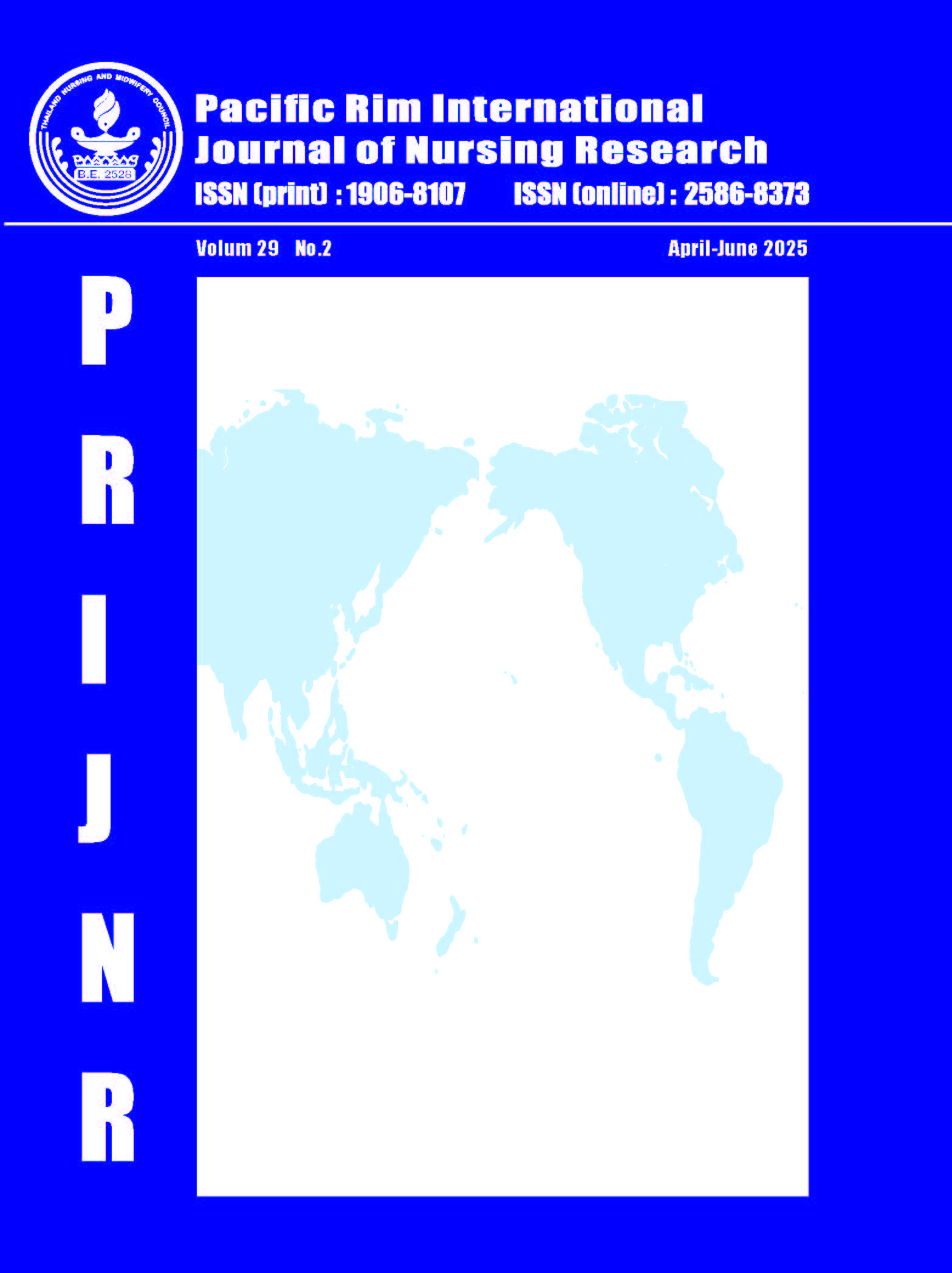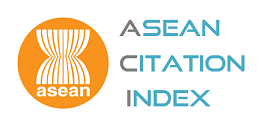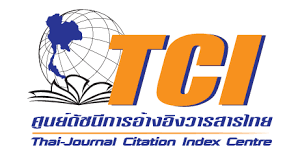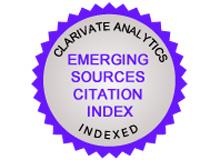Activities of Daily Living and Determinant Factors among Sepsis Survivors during Hospitalization: A Cross-Sectional Study
DOI:
https://doi.org/10.60099/prijnr.2025.271797Keywords:
Activities of daily living, Healthcare personnel support, Sepsis, Severity, Sleep quality, Serum albumin, SurvivorsAbstract
Sepsis survivors are increasing in number, but unfortunately, they encounter limitations in performing activities of daily living during hospitalization. This study aimed to investigate the factors predicting activities of daily living among sepsis survivors during hospitalization based on the conceptual framework of the International Classification of Functioning, Disability, and Health. Adults who had survived for more than 48 hours after sepsis diagnosis and were admitted to general medicine units in a university hospital in Thailand were recruited by purposive sampling (N = 109). The instruments for data collection included a Demographic and Medical Information Questionnaire, a Sequential Organ Failure Assessment Scale, the Verran and Snyder–Halpern Sleep Scale, the Caring Professional Scale, and the Barthel Index Scale. Multiple linear regression was used to determine predictability.
Based on the findings, 45.9% of the sepsis survivors studied had dependent status. Age, sleep quality, and sepsis severity together accounted for 50.6% of the variability in the ADLs of the sepsis survivors during hospitalization. Nurses and multidisciplinary teams can apply the knowledge gained from the findings by enhancing and managing determinant factors to improve activities of daily living during hospitalization. Activities of daily living assessments at specific times and longitudinal studies should be considered for future studies.
References
Sepsis Alliance. Sepsis survivors [Internet]. 2022 [cited 2022 Sept 27]. Available from: https://www.sepsis.org/sepsis-survivor-week.
Permpikul C, Sivakorn C, Tongyoo S. In-hospital death after septic shock reversal: a retrospective analysis of in-hospital death among septic shock survivors at Thailand's largest national tertiary referral center. Am J Trop Med Hyg. 2021;104:395–402. doi:10.4269/ajtmh.20-0896.
Huang CY, Daniels R, Lembo A, Hartog C, O'Brien J, Heymann T, et al. Life after sepsis: an international survey of survivors to understand the post-sepsis syndrome. Int J Qual Health Care. 2019;31:191–8. doi:10.1093/intqhc/mzy137.
Ferreira NA, Lopes AJ, Ferreira AS, Ntoumenopoulos G, Dias J, Guimaraes FS. Determination of functional prognosis in hospitalized patients following an intensive care admission. World J Crit Care Med. 2016;5:219–27. doi:10.5492/wjccm.v5.i4.219.
Mostel Z, Perl A, Marck M, Mehdi SF, Lowell B, Bathija S, et al. Post-sepsis syndrome: an evolving entity that afflicts survivors of sepsis. Mol Med. 2020;26:6. doi:10.1186/s10020-019-0132-z.
Beumeler LFE, van Wieren A, Buter H, van Zutphen T, Bruins NA, de Jager CM, et al. Patient-reported physical functioning is limited in almost half of critical illness survivors 1-year after ICU-admission: a retrospective single-centre study. PLoS One. 2020;15:e0243981. doi:10.1371/journal.pone.0243981.
Doungsuriya P, Chanruangvanich W, Chayaput P, Thosingha O. Factors predicting severity of physiological deterioration among sepsis patients in emergency department. JTNMC [Internet]. 2021 Jun. 30 [cited 2022 Oct. 25];36(3):134-50. Available from: https://he02.tci-thaijo.org/index.php/TJONC/article/view/249655 (in Thai).
Miyamoto K, Shibata M, Shima N, Nakashima T, Tanaka R, Nakamoto K, et al. Incidence and risk factors of worsened activities of daily living status three months after intensive care unit discharge among critically ill patients: a prospective cohort study. J Clin Med. 2022;11:1990. doi:10.3390/jcm11071990.
Puthucheary ZA, Gensichen JS, Cakiroglu AS, Cashmore R, Edbrooke L, Heintze C, et al. Implications for post critical illness trial design: sub-phenotyping trajectories of functional recovery among sepsis survivors. Crit Care. 2020;24:577. doi:10.1186/s13054-020-03275-w.
Turjeman A, Koppel F, Franceschini E, Yahav D, Dolci G, Babich T, et al. Risk factors for functional decline among survivors of gram-negative bloodstream infection: a prospective cohort study. PLoS One. 2021;16:e0259707. doi:10.1371/journal.pone. 0259707.
Nakano H, Hashimoto H, Mochizuki M, Naraba H, Takahashi Y, Sonoo T, et al. Hypoalbuminemia on admission as an independent risk factor for acute functional decline after infection. Nutrients. 2020;13:26. doi:10.3390/nu13010026.
World Health Organization. International classification of functioning, disability and health (ICF) [Internet]. 2001 [cited 2022 Sept 15]. Available from: https://iris.who.int/bitstream/handle/10665/42407/9241545429.pdf;jsessionid=5650A1C035FC8293AB79F798D7FABB36?sequence=1.
Walter EJ, Hanna-Jumma S, Carraretto M, Forni L. The pathophysiological basis and consequences of fever. Crit Care. 2016;20:200. doi:10.1186/s13054-016-1375-5.
Le Thuc O, Stobbe K, Cansell C, Nahon JL, Blondeau N, Rovère C. Hypothalamic inflammation and energy balance disruptions: spotlight on chemokines. Front Endocrinol. 2017;8:197. doi:10.3389/fendo.2017.00197.
Yoshihara I, Kondo Y, Okamoto K, Tanaka H. Sepsis-associated muscle wasting: a comprehensive review from bench to bedside. Int J Mol Sci. 2023;24:5040. doi: 10.3390/ijms24055040.
Hyatt HW, Powers SK. Mitochondrial dysfunction is a common denominator linking skeletal muscle wasting due to disease, aging, and prolonged inactivity. Antioxidants. 2021;10:588. doi:10.3390/antiox10040588.
Wang W, Xu C, Ma X, Zhang X, Xie P. Intensive care unit-acquired weakness: a review of recent progress with a look toward the future. Front Med. 2020;7:559789.doi: 10.3389/fmed.2020.559789.
Dobing S, Frolova N, McAlister F, Ringrose J. Sleep quality and factors influencing self-reported sleep duration and quality in the general internal medicine inpatient population. PLoS One. 2016;11:e0156735. doi:10.1371/journal.pone.0156735.
Apitzsch S, Larsson L, Larsson AK, Linder A. The physical and mental impact of surviving sepsis - a qualitative study of experiences and perceptions among a Swedish sample. Arch Public Health. 2021;79:66. doi:10.1186/s13690-021-00585-5.
Logie CH, Wang Y, Lacombe-Duncan A, Wagner AC, Kaida A, Conway T, et al. HIV-related stigma, racial discrimination, and gender discrimination: pathways to physical and mental health-related quality of life among a national cohort of women living with HIV. Prev Med. 2018;107:36–44. doi:10.1016/j.ypmed.2017.12.018.
Singer M, Deutschman CS, Seymour CW, Shankar-Hari M, Annane D, Bauer M, et al. The third international consensus definitions for sepsis and septic shock (sepsis-3). JAMA. 2016;315:801–10. doi:10.1001/jama.2016.0287.
Wakabayashi H, Sashika H. Malnutrition is associated with poor rehabilitation outcome in elderly inpatients with hospital-associated deconditioning a prospective cohort study. J Rehabil Med. 2014;46:277–82. doi:10.2340/16501977-1258.
Borson S, Scanlan J, Brush M, Vitaliano P, Dokmak A. The mini-cog: a cognitive 'vital signs' measure for dementia screening in multi-lingual elderly. Int J Geriatr Psychiatry. 2000;15:1021–7. doi:10.1002/1099-1166(200011)15:11<1021::aid-gps234>3.0.co;2-6.
Vincent JL, Moreno R, Takala J, Willatts S, De Mendonça A, Bruining H, et al. The SOFA (sepsis-related organ failure assessment) score to describe organ dysfunction/failure. Intensive Care Med. 1996;22:707–10. doi:10.1007/BF01709751.
Snyder-Halpern R, Verran, JA. Instrumentation to describe subjective sleep characteristics in healthy subjects. Res Nurs Health. 1987;155-63. doi:10.1002/nur.4770100307.
Rojjanakitti P. Relationships between personal factors, environmental factors, and sleep quality in surgical patients after operation [dissertation]. [Bangkok]: Chulalongkorn University; 2001.
Swanson KM. Caring professional scale. In Watson, J. (Ed), Assessing and measuring caring in nursing and health science. Springer. 2000; 203-6.
Piyasiripan K. Caring behaviors of nurses as perceived by patients in intensive care unit [master’s thesis]. [Chiang Mai]: Chiang Mai University; 2002.
Mahoney FI, Barthel DW. Functional evaluation: the Barthel index. Md State Med J [Internet]. 1965[cited 2022 Oct. 20];14:61-5. Available from: https://www.kcl.ac.uk/nmpc/assets/rehab/tools-bi-functional-evaluation-the-barthel-index.pdf.
Mapi Research Trust. Barthel Index (Barthel Index) [internet]. 2022 January [cite 2022 Dec 8]. Available from: https://eprovide.mapi-trust.org/instruments/barthel-index.
Arshad A, Ayaz A, Rehman S, Ukrani RD, Akbar I, Jamil B. Progression of acute kidney injury to chronic kidney disease in sepsis survivors: 1-year follow-up study. J Intensive Care Med. 2021;36:1366–70. doi:10.1177/0885066620956621.
Liang CC, Yeh HC, Chen PS, Kuo CC, Chiang HY. Sepsis-associated acute kidney injury and acute kidney disease: a 15-year cohort study of 4,226 adult sepsis inpatient survivors at a tertiary medical center in Taiwan. Open Forum Infect Dis. 2021;8:S6-7. doi:10.1093/ofid/ofab466.008.
Voiriot G, Oualha M, Pierre A, Salmon-Gandonnière C, Gaudet A, Jouan Y, et al. Chronic critical illness and post-intensive care syndrome: from pathophysiology to clinical challenges. Ann Intensive Care. 2022;12:58. doi:10.1186/s13613-022-01038-0.
Yang T, Li Z, Jiang L, Wang Y, Xi X. Risk factors for intensive care unit-acquired weakness: a systematic review and meta-analysis. Acta Neurol Scand. 2018;138:104–14. doi:10.1111/ane.12964.
McLaughlin J, Chowdhury N, Djurkovic S, Shahab O, Sayiner M, Fang Y, et al. Clinical outcomes and financial impacts of malnutrition in sepsis. Nutr Health. 2020;26:175–8. doi:10.1177/0260106020930145.
Darden DB, Kelly LS, Fenner BP, Moldawer LL, Mohr AM, Efron PA. Dysregulated immunity and immunotherapy after sepsis. J Clin Med. 2021;10:1742. doi:10.3390/ jcm10081742.
Mankowski RT, Anton SD, Ghita GL, Brumback B, Darden DB, Bihorac A, et al. Older adults demonstrate biomarker evidence of the persistent inflammation, immuno suppression, and catabolism syndrome (PICS) after sepsis. J Gerontol A Biol Sci Med Sci. 2022;77:188–96. doi:10.1093/gerona/glab080.
Gritte RB, Souza-Siqueira T, Curi R, Machado MCC, Soriano FG. Why septic patients remain sick after hospital discharge? Front Immunol. 2021;11:605666. doi:10.3389/fimmu.2020.605666.
Umberger RA, Thomas SP. Survivor but not fully recovered: the lived experience after 1 year of surviving sepsis. Dimens Crit Care Nurs. 2019;38:317–27. doi:10.1097/DCC. 0000000000000381.
Elías MN, Munro CL, Liang Z, Calero K, Ji M. Sleep and intensive care unit-acquired weakness in critically ill older adults. Dimens Crit Care Nurs. 2019;38:20–8. doi:10.1097/DCC.0000000000000335.
Downloads
Published
How to Cite
Issue
Section
Categories
License
Copyright (c) 2025 Pacific Rim International Journal of Nursing Research

This work is licensed under a Creative Commons Attribution-NonCommercial-NoDerivatives 4.0 International License.
Copyright: The Pacific Rim International Journal of Nursing Research, Thailand Nursing & Midwifery Council has exclusive rights to publish, reproduce and distribute the manuscript and all contents therein.







.png)


